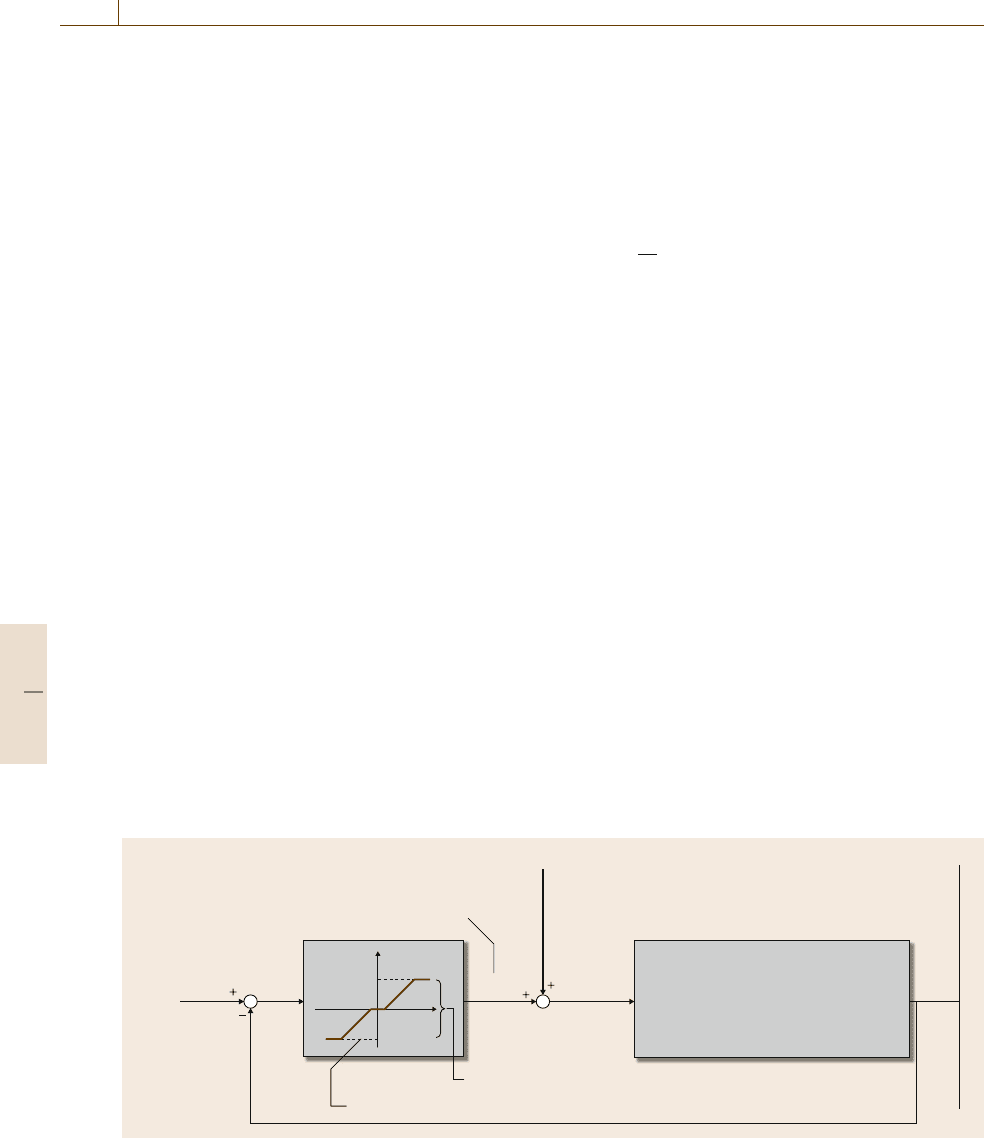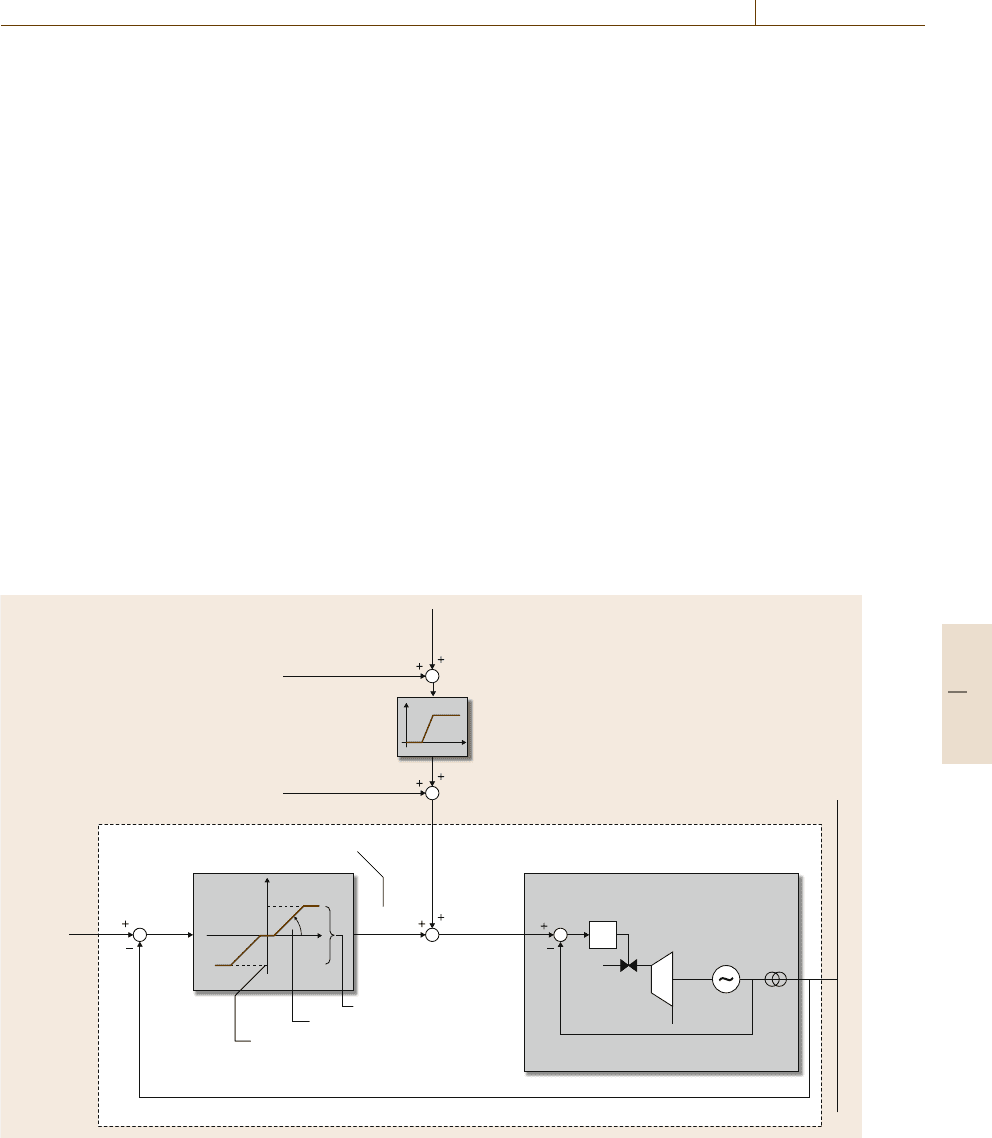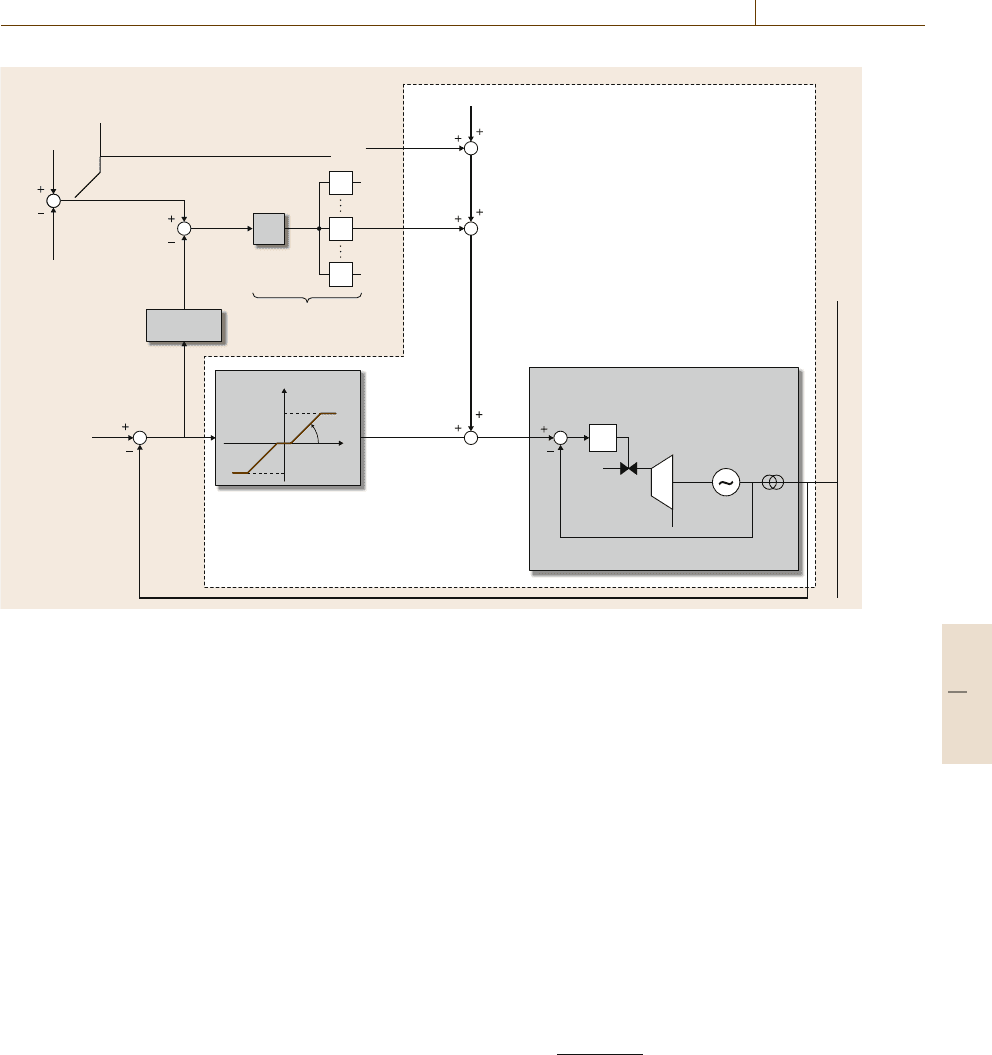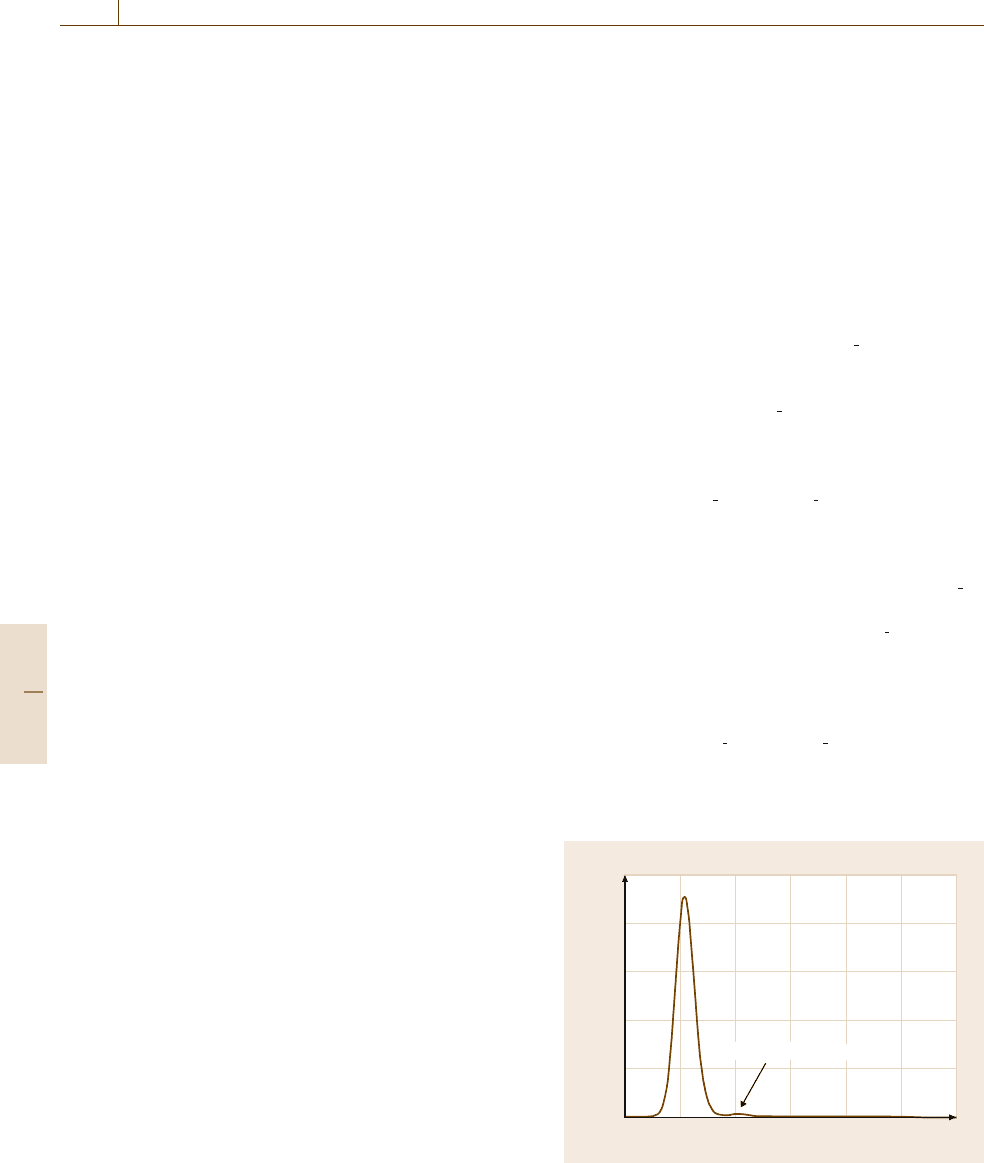Nof S.Y. Springer Handbook of Automation
Подождите немного. Документ загружается.


Securing Electrical Power System Operation 65.1 Power Balancing 1145
fact that the manipulated variable is active power, a sin-
gle variable, we have to deal with a number of outputs
due to the fact that there are many actuators with differ-
ent characteristics spread throughout the power system.
Differentturbo generatorshavedifferent control regions
and dynamics. Some units are in a standby mode and it
takes some time to start them up and reach synchronous
speed. There are several modes in which theunit control
system can run. Thus, each producer can offer the TSO
a certain amount of reserve power in several categories
of AS. The TSO defines the portfolio of ancillary ser-
vices which might differ from country to country, state
to state, or area to area, and runs an AS market where
a TSO purchases balancing power reserves for poten-
tial use. Examples of AS we deal with in this chapter
when explaining a method of AS planning are shown in
Table 65.2.
Ancillary services that are activated automatically
are primary and secondary controls. The functionality
of primary frequency control, or rather activation of the
active power reserve RZPR, is distributed throughout
the control area, and is part of a speed governor control
system operating in droop control mode.
Activation of the secondary power reserve is con-
ducted by the central TSO’s control system. This
scheme is associated with the term automatic gen-
eration control (AGC), which means the automatic
adjustment of a control area’s generation from a cen-
tral location to maintain its interchange schedule plus
frequency bias. AGC is also known as a load-frequency
controller. Generators under secondary control (UCTE)
must reach the demanded increase/decrease in power
output within 10min at a rate of at least 2MW/min.
The remaining AS, used predominantly for energy
imbalance management and during contingencies, are
dispatched by the TSO manually.
Let us define basic terms before describing the
methodology for AS planning.
Table 65.2 Examples of ancillary services and their categories
Generic AS Preferreduse Area-specific Response time
AS identifier
Continuous regulation Spinning Primary frequency control RZPR ≈30 s
Continuous regulation Spinning Secondary power and frequency control RZSR ≤ 15min
Energy imbalance management Spinning Load following RZTR
+
≤30 min
RZTR
−
Instantaneous contingency reserve Nonspinning Operating reserve RZQS ≤ 15min
Replacement reserve Nonspinning Dispatch reserve RZN
>30
> 30 min
65.1.5 System Frequency
The electrical frequency in the network, the system fre-
quency f , is a measure of the rotation speed of the
synchronized generators.As the total demand increases,
the system frequency will decrease, and vice versa. The
turbine speed controller performs an automatic primary
control action to balance demand and generation. The
frequency deviation Δ f is influenced by both the total
inertia in the system and the speed of primary control.
Under undisturbed conditions, the system frequency
must be maintained within strict limits in order to en-
sure the full and rapid deployment of control facilities
in response to a disturbance.
65.1.6 Primary Frequency Control
The objective of primary frequency control (PR)is
to maintain a balance between generation and con-
sumption within the synchronous area using turbine
speed governors. PR is an automatic function dis-
tributed throughout the network. When the generator
is part of a large power system, and electrical power
generation is shared by two or more machines, the fre-
quency (speed) cannot be controlledsuch that it remains
constant because it would forbid generation sharing
between various synchronous generators. Control with
speed droop is the solution that allows for fair genera-
tion sharing.
PR stabilizes the system frequency in seconds after
a disturbance. In principle, the control law is propor-
tional and the controlled system does not have integral
character. The result is the steady state error in system
frequency and, in addition, scheduled power exchanges
between areas are not restored. Through the joint action
of all primary controllers, PR ensures the operational
reliability of the power system of the synchronous area.
It stabilizes the frequency, but cannot drive the system
Part G 65.1

1146 Part G Infrastructure and Service Automation
frequency back to the original setpoint value and cannot
restore cross-border power exchanges in the intercon-
nected system,so they will differ from the values agreed
between parties.
The overshoot or undershoot of the system fre-
quency is a function of the amplitude and dynamics
of the disturbance affecting the balance between power
output and consumption, the kinetic energy of rotat-
ing machines in the system, the number of generators
subject to PR (i.e., the primary control reserve and
its distribution between these generators), the dy-
namic characteristics of the machines and their control
systems, and the dynamic characteristics of loads, par-
ticularly the self-regulating effect of loads.
The steady state error of the system frequency is
a function of the amplitude of the disturbance and the
gain of the proportional controller, which is associ-
ated withthe so-called network power systemfrequency
characteristic.
Starting from undisturbed operation of the UCTE
network [65.6], a sudden loss of 3000MW of generat-
ing capacity must be offset by primary control alone,
without the need for customer load-shedding in re-
sponse to a frequency deviation. In addition, when the
self-regulating effect of the system load is assumed to
be 1%/Hz, the absolute frequency deviation must not
exceed 180mHz. Likewise, the sudden load-shedding
of 3000MW in total must not lead to a frequency devi-
ation exceeding 180mHz.
The primary control reserve for the entire syn-
chronous area RZPR, also referred to as a continuous
regulation reserve, is determined by the required
performance described above, taking into account mea-
surements, experience and theoretical considerations.
System
frequency
reference
Power of the primary regulation
activated in the area
External load setpoint variation (AGC, EMS)
Primary area control range
Load
setpoint
ΔP
PR
ΔP
PR
Δf
Δf
f
0
f
actual
λ
+RZPR
–RZPR
(MW)(Hz)
Area
turbo-generators
(Hz)
Grid
Primary control reserve in the area
Fig. 65.4 Diagram showing the principle of the primary frequency control loop in the area
The share RZPR
i
of the control area i is defined by mul-
tiplying the calculated reserve for the synchronous area
and the contribution coefficient C
i
of the control area
RZPR
i
=RZPRC
i
, (65.1)
where the contribution coefficient C
i
is calculated on
a regular basis for each control area or TSO using
C
i
=
E
i
E
,
(65.2)
where E
i
is the electricity generated in control area i
and E is thetotal electricity producedin allcontrol areas
of the synchronous interconnection.
A deviation in system frequency Δ f will, in the
steady state, release primary control power throughout
the synchronous area ΔP
PR
as
ΔP
PR
=λΔ f ,
(65.3)
where the gain λ is called the power system frequency
characteristic of the synchronous area and λ is the sum
of the power system frequency characteristics of all ar-
eas that are synchronously connected.
Each TSO is required to maintain a network power-
frequency characteristic λ
i
of the control area that is
derived from the power-frequency characteristic de-
signed for the overall synchronous area λ and the area
contribution coefficient C
i
λ
i
=C
i
λ. (65.4)
Each interconnected TSO must activate primary con-
trol power that is adequate for the system frequency
deviation Δ f using
ΔP
PR
i
=λ
i
Δ f , (65.5)
Part G 65.1

Securing Electrical Power System Operation 65.1 Power Balancing 1147
where ΔP
PR
i
is the power variation generated locally
in the control area in response to a frequency devi-
ation caused by a disturbance (e.g., generation unit
outage).
Figure 65.4 shows the principle of the primary con-
trol loop for the area. Note that the index of the area i
is omitted from all power variables and λ for simplicity.
The block diagram should actually be split further into
control loops of individual turbo generators,as shown in
Fig.65.5. Generating units should deliver programmed
(contracted) active power and provide power balancing
functionality through primary, secondary and tertiary
control atthe same time. Theprogrammed power is thus
modified locally by primary frequency control indepen-
dently of all other methods of power balancing used
centrally by the TSO.
Primary control is performed by the speed gov-
ernors of the generating units. With primary control,
a variation in system frequency that is greater than the
dead band will result in a change in unit power gen-
eration. Generators are required to participate in this
control by setting the droop, which is directly related
to the gain of the speed governor in Fig. 65.5, accord-
System
frequency
reference
Power of the primary regulation
activated in the unit
Service temporal characteristics
(response delay, ramping, ...)
Utility EMS (load following, economic dispatch)
EMS (load following,
economic dispatch)
AGC (regulation)
Area balancing
Primary control range
~ Generator droop
Load
setpoint
Load governor
Turbine
Actual load
Valve
Generator
ΔP
TR j
ΔP
TRj
ΔP
SRj
ΔP
TRj
Δf
Δf
f
0
f
actual
p
program j
(MW)(Hz)
Turbo-generator
(Hz)(MW)
Grid
Primary control reserve of the generator
Frequency (speed) governor
PI
Unit running in droop control mode
Fig. 65.5 Diagram showing the principle of the primary frequency control loop for a generating unit
ing to specifications defined by the TSO. Transients of
primary control have a timescale of seconds.
Power engineering is an area where different disci-
plines use different words for the same function, and
many power engineers get frustrated when the literature
fails to define or mention the terms droop, isochronous
or speed/load, which refer to generator control [65.7].
Here are a few examples.
Rotating equipment people refer to droop control.
The governor droop characteristic of a generation unit
is given by the frequency deviation (% with respect to
the nominal frequency) needed to change the generation
power output (% with respect to nominal output) multi-
plied by 100. For example, a 5% droop means that a 5%
frequency deviation causes a 100% change in power
output. However, controls or instrumentation specialists
would call this proportional control and might not even
recognize the term droop. Frequently, utilities or pow-
erhouse people will refer to this as speed/load control
and may not recognize either of the other terms.
By the same token, people witha rotatingequipment
background will refer to isochronous control. Control
engineers will call this PID control, and utilities or pow-
Part G 65.1

1148 Part G Infrastructure and Service Automation
erhouse people will use the terms frequency or speed
control to refer to the same thing.
The synchronous generator is operated in frequency
(isochronous) control mode when disconnected from
the grid and is switched to droop control when synchro-
nized and connected to the grid. On a small electrical
grid, one machine is usually operated in isochronous
speed control mode, maintaining the system frequency
using a PID control loop. Any other (usually smaller)
generators that are connected to the grid are operated
in droop speed control mode, running under P control.
If two prime movers operating in isochronous speed
control mode are connected to the same electrical grid,
they will usually fight to control the frequency, and
wild oscillations of the grid frequency usually result.
Only one machine can have its governor operating in
isochronous speed control mode for stable grid fre-
quency control when multiple units are being operated
in parallel.
In very large electrical grids, commonly referred to
as infinite electrical grids, there is no single machine
operating in isochronous speed control mode that is ca-
pable of controlling the grid frequency, and all of the
prime movers are operated in droopspeed controlmode.
However, there are so many of them and the electrical
grid is so large that no single unit can cause the grid fre-
quency to increase or decrease by more than a fraction
of a percent as it is loaded or unloaded.
Very large electrical grids require system operators
to quickly respond to changes in load in order to control
grid frequency properly, since there is no isochronous
machine that does so. Usually, when things are oper-
ating normally, changes in load can be anticipated and
additional generation can be added or subtracted in or-
der to maintain tight frequency control.
65.1.7 Secondary Frequency
and Power Control
Secondary control (SR) drives the system frequency
and cross-border power exchanges back to the original
desired (programmed) values after 15–30min if the ac-
tivated power does not reach the saturation limit of the
reserve acquired. To prevent saturation and loss of sec-
ondary control functionality, additional power should be
released to the system by activating reserves other than
the primary balancing power reserves.
Transients of secondary control are on the order of
minutes. Secondary control is also called AGC.Inad-
dition, AGC distributes the imbalance between selected
units in an economical way. AGC is usually provided
by the area’s balancing authority, the TSO in the case of
UCTE interconnection. Generation scheduling and con-
trol is an important component of daily power system
operation. The overall objective is to control the elec-
trical output of generating units in order to supply the
continuously changing customer power demands in an
economical manner. Much of this functionality is pro-
vided by AGC as run by the balancing authority (TSO)
and related functions operating within a utility control
center energy management system (EMS).
Figure 65.6 shows a block diagram of the automatic
SR control system, the function of which is realized by
the TSO.
The output signal of the secondary PI controller
ΔP
SR
is distributed over participating generators with
participating factors α
1
,...,α
n
.
The function of SR, also known as load-frequency
control or frequency-power control, is to keep or to
restore the power balance in each control area, and con-
sequently, to keep or to restore the system frequency f
to its set-point value and the power interchanges with
adjacent control areas to their programmed, scheduled
values. This will ensure that the full reserve of primary
control power RZPR will be recovered.
Whereas all control areas of the interconnection
participate in providing primary control power, only
the control area affected by a power imbalance is
required to undertake secondary action for the cor-
rection. Parameters for the secondary control schemes
are set such that only the controller in the zone af-
fected by the disturbance concerned will respond and
initiate the deployment of the requisite secondary con-
trol power. Within a given control area, the demand
should be covered at all times by electricity produced in
that area, including electricity imports (under purchase
contracts and/or electricity production from jointly op-
erated plants outside the zone concerned). Secondary
control is applied to selected generator units in the
power plants comprising the control loop.
Since it is technically impossible to guard against
all random variables affecting production, consumption
or transmission, the volume of reserve capacity will de-
pend upon the level of acceptable risk. These principles
will apply regardless of the distribution of responsibili-
ties betweenthe partiesinvolved in supplying electricity
to consumers.
In order to determine whether power interchange
deviations are associated with an imbalance in the con-
trol area concerned or with the activation of primary
control power, a corrective term should be introduced
into the power interchange deviation. This is known
Part G 65.1

Securing Electrical Power System Operation 65.1 Power Balancing 1149
K-factor
K = 1.1λ
Generation unit
operating in droop
(frequency/load) mode
TSO
Primary reserve
activated in the unit
Turbine
Actual load
Speed
governor
Generator
ΔP
PR j
P
ref j
ΔP
PR j
ΔP
TRj
ΔP
SRj
Δf
λ
Δf
dP
f
0
f
measured
p
program j
α
1
α
j
α
n
(Hz)
Turbo-generator control system
running in load mode
(MW)
(MW)
ACE
PI
Grid
Interchange measured
Power
interchange
deviation
Interchange programmed (> 0 export, < 0 import)
<0 unintended export from the area
>0 unintended import to the area
Secondary reserve
activation in the area
PI
Fig. 65.6 Diagram showing the principle diagram of the secondary frequency and power control loop
as the network characteristic method, and its func-
tion is shown through the K-factor link displayed in
Fig.65.6. Due to the uncertainty in the self-regulating
effect of the load, the K-factor K
j
may be chosen to be
slightly higher than the rated value of the power system
frequency characteristic λ
j
, such that the SR will accen-
tuate the effect of the PR. Each control area is equipped
with one secondary controller to minimize the ACE in
real time:
ACE = P
programmed
−P
measured
−K
(
f
0
− f
measured
)
,
(65.6)
where P
measured
is the sum of the instantaneous meas-
ured active power transfers on the tie-lines, P
programmed
is the exchange program with all the adjacent control
areas, K is the K-factor of the control area, a con-
stant (MW/Hz), f
0
is the setpoint, and f
measured
is the
instantaneous measured system frequency.
The ACE is thecontrol area’s imbalance P
programmed
−P
measured
with the hidden effect of the area’s primary
control. A different sign convention may be used for
ACE relative to the respective TSO. In this chapter, the
power transits are considered positive for export and
negative for import. Hence, a positive (a negative) ACE
requires an increase (a decrease) in the secondary con-
trol power. The ACE must be kept close to zero in each
control area at all times.
The secondary controller is implemented as a PI
controller with additional features such as anti-wind-up
and rate limiting.
The secondary control range RZSR is the range of
adjustment of the secondarycontrol power ΔP
SR
within
which the secondary controller can operate automati-
cally in both directions (positive and negative).
In control areas of different sizes, load variations of
varying magnitude must be corrected within approxi-
mately 15 min. The size of the RZSR required depends
on the typicalload variation, schedule changes,and gen-
erating units. The minimum value for the RZSR related
to load variations in MW, recommended in UCTE,is
obtained using the empirical formula
RZSR =
,
aL
max
+b
2
−b , (65.7)
where L
max
is the maximum anticipated load in MW
for the control area, and the parameters a and b are es-
tablished empirically, with the following values used by
the UCTE: a =10MW and b =150MW.
Part G 65.1

1150 Part G Infrastructure and Service Automation
If consumption exceeds production for longer pe-
riods, immediate action must be applied using tertiary
control, standby supplies, or contractual load shedding
as a last resort.
Secondary reserve is also referred to as continuous
regulation reserve.
65.1.8 Tertiary Reserve
The active power ΔP
TR
of a tertiary reserve RZTR is
usually activated manually by the TSO to free up an
exhausted secondary reserve so that it can effectively
reject common fluctuations. Tertiary control action in-
volves a signal being sent by the TSO to a producer
whose generating unit is included in the tertiary con-
trol scheme requesting that the control range of the
unit should be changed (e.g., by changing the operat-
ing point of the boiler). This usually takes some time,
and the frequency of such actions is also limited. The
function of the tertiary control can be viewed as a dy-
namic changein the active power setpoint,which in turn
moves the use of the secondary control reserve away
from its limit value. The reserve denoted RZTR
−
is
used to decrease the output and RZTR
+
to increase the
output.
Tertiary control isan economic dispatch.It is usedto
drive the system as economicallyas possible and restore
security levels if necessary.
The AS provider must provide the requested portion
of the regulating reserve within a specified time limit
(e.g., 30min) and at a specified minimum rate, typically
2MW/min.
The tertiary reserve is a load-following spinning re-
serve.
65.1.9 Quick-Start Reserve
The quick-start reserve (RZQS) is usually provided by
pumped-storage powerstations that are able tostart gen-
eration within 10min. The preferred use of RZQS is to
compensate for large and sudden deviations due to gen-
erator outage. This reserve is activated manually from
the TSO’s control center. As the capacity of water reser-
voirs is limited, the use of the quick-start reserve is
restricted in time.
The quick-start reserve is also referred to as the con-
tingency nonspinning reserve.
65.1.10 Standby Reserve
The standby reserve (RZDZ) is typically represented by
combined-cycle gas-turbine generation units. Depend-
ing on their ability to reach nominal output within the
agreed time, they may be in the category RZN
+
30
or
RZN
>30
. The standby reserves are typically activated
in the case of a generator outage or a longer-lasting
deficit of energy in the system caused by some other
reason.
The standby reserve falls into the category of a con-
tingency replacement (supplemental) reserve.
65.1.11 Planning Reserves
There are lots of constraints that must be considered
when planning reserves. The following nonusable ca-
pacity must be taken into account when calculating the
capacity needed to meet power requirements: units sub-
ject to long-term shutdown; units shut down for repair
and maintenance; limits on capacity associated with re-
strictions in fuel supplies; limits on capacity associated
with environmental restrictions; limits on the capacity
of hydroelectric plants associated with hydraulic and
environmental constraints; the primary control reserve;
reserves to cover variations in production and consump-
tion (secondary and tertiary reserves).
In addition to these factors, which are directly asso-
ciated with production, system conditions must also be
considered, given that network constraints may limit the
transmission of the power produced.
From the TSO point of view, the support system for
AS planning should read the reliability requirements for
power balance control and provide recommendations
for the optimal composition of the AS,whichtheTSO
should then acquire on the market. In particular, thesys-
tem should be able to answer the following questions:
•
What amount of reserves in the form of AS is
needed in each category to insure that power bal-
ancing is realized with the desired reliability?
•
What can providersof ASon themarket be expected
to offer in terms of their volumes and prices?
•
How should the AS be selected based on the offer
to insure that the requirements are covered in the
optimal way?
•
What are the expected costs associated with a cer-
tain level of operational reliability of the transmis-
sion system?
Similar tasks have emerged in all countries that have
gone or are going through the liberalization pro-
cess. From a global perspective, the safe operation of
a transmission system can be viewed as a multicriteria
optimization task. Due to a strong interaction between
Part G 65.1

Securing Electrical Power System Operation 65.1 Power Balancing 1151
the technical and economic consequences of the plan-
ning and operating decisions, the two basic competing
criteria – quality of electricity and costs of operating
the transmission system – must be considered simulta-
neously.
Optimal planning of the AS involves market mod-
eling [65.3]. Three main modeling trends can be
identified: optimization models, which focus on a profit
maximization problem for one of the players compet-
ing on the market; equilibrium models, which represent
the overall market behavior, taking into account compe-
tition amongst all participants; and simulation models,
often based on multiagent systems, which are an al-
ternative to equilibrium models in cases where the
problem under consideration is too complex. The mod-
els use a variety of computational techniques: linear
programming, mixed integer programming, dynamic
programming, nonlinear programming, heuristic ap-
proaches, and others.
Many papers focus on the pricing and optimal
procurement of the energy and AS. If the market
products (energy and AS) are procured simultaneously
through central (usually day-ahead) auctions, the task
to solve is to simultaneously co-optimize energy and
AS ensuring that costs are minimized but safe op-
eration of the transmission system is retained. This
involves addressing issues such as optimizing power
flow, unit commitment, congestion management and
emission constraints [65.4–8]. The products on the
market may be procured sequentially through central
auctions managed by the ISO/TSO, usually in the fol-
lowing order: energy market, transmission market to
resolve congestions (if needed), and market for each
category of the AS (from the fastest-responding to the
slowest-responding service). In such cases, the prob-
lem of how to optimally purchase AS taking into
account the downward substitutability of the AS arises,
since the market clearing price in each market de-
pends on the volume required. A rational buyer’s
algorithm described in papers [65.9,10] can handle this
problem.
However, the complex task of optimally planning
AS is still a challenging one. Although methods solving
some ofthe partialsubtasks exist, they must be carefully
chosen and modified to fit in the context of a specific
country or region. The inner structure of the global AS
planning problem may also vary from country to coun-
try.
Let’s assume that the generation portfolio of a par-
ticular control area consists of dozens of 110MW and
200MW generation units, some 500 MW and 1000 MW
generation units, andthat the peakload is approximately
11GW. Let’s also assume a dense network so that no
inner flow congestion management is needed; capacity
auctions will only be organized for cross-border tie-
lines.
This control area is part of the European syn-
chronous interconnection (UCTE), and as such its
operation must comply with the UCTE rules [65.6]and
relevant legislation, which (among others) states the li-
ability of the TSO for frequency and power balance
maintenance. For this purpose, the TSO purchases most
of the AS through free-market tenders organized typi-
cally for three-year and one-year periods. The TSO only
spends money on reserving the AS (purchase); the costs
of AS activation are covered later by the market partic-
ipants that cause the power imbalance. Hence, for the
rest of the chapter, when we refer to the cost of AS,we
mean the cost of reserving the AS.
Energy markets are separate from AS markets. Most
energy is traded in the form of bilateral contracts for
base-load products on a year-ahead basis. Peak-load
products are mainly associated with short-term energy
markets. We assume that the TSO is not allowed to
participate in energy markets.
65.1.12 Performance Criteria
Different interconnections may have chosen and use
slightly different performance criteria to evaluate the re-
liability of system services in terms of power balancing.
The North American Electric Reliability Cor-
poration (NERC) defines three control performance
standards (CPS) for the assessment of control area
generation control performance: CPS1, CPS2 and
DCS [65.11]. All control areas in North America im-
plemented CPS in 1998.
CPS1. Each balancing authority operates such that, on
a rolling twelve-month basis, the scaled average of
clock-minute averages of the ACE of the area multi-
plied bythe corresponding clock-minute averages ofthe
interconnection’s frequency error is less than a specific
limit. The index of the area i will be omitted for the
rest of the chapter for simplicity, as our discussion only
concerns a single area of the interconnection.
CPS1 is a statistical measure of ACE variability.
CPS1 measures ACE in combination with the inter-
connection’s frequency error. CPS1 requires that the
average of the clock-minute averages of a control area’s
ACE over a given period divided by its K factor mul-
tiplied by the corresponding clock-minute averages of
Part G 65.1

1152 Part G Infrastructure and Service Automation
the frequency error should be less than a given constant
AV G
Period
ACE
K
area
Δ f
≤ε
2
1
. (65.8)
The constant ε
1
is derived from the targeted fre-
quency bound (the targeted RMS value of one-minute
average frequency error based on frequency perfor-
mance over a given year). For the purpose of control
performance evaluation, CPS1 is evaluated monthly for
the previous (sliding) twelve-month period.
CPS1 measures control performance by comparing
how well a control area’s ACE performs in conjunc-
tion with the frequency error of the interconnection.
Equation 65.8 can be viewed as a correlation between
ACE and Δ f . Positive correlation means undesirable
performance (the area control error contributes to the
frequency deviation from the desired value) and is
therefore limited by the upper bound ε
2
1
.Negativecor-
relation occurs when ACE helps to compensate the total
ACE of the interconnection and is helping to offset the
system frequency deviation.
CPS2. The other criterion, CPS2, is designed to bound
ten-minute ACE averages and provides an oversight
function to limit excessive unscheduled power flows
that could result from large ACE
AV G
10 minute
(ACE) ≤ε
10
,
K
area
K
interconnection
,
(65.9)
where K
interconnection
is the sum of the K factorsinthe
entire interconnection and ε
10
is the targeted RMS of
the ten-minute average frequency error. Each balanc-
ing authority operates such that its average ACE for
at least 90% of the ten-minute periods (six nonoverlap-
ping periods per hour) during a calendar month is within
a specific limit, referred to as L
10
. Extensive analysis
and further discussions of the two performance indices
can be found in [65.11–14].
NERC does not have the statutory authority to en-
force compliance with its reliability standards. Despite
its lack of authority, NERC has made every effort to
continuously clarify and upgrade its reliability stan-
dards as the electrical power industry has evolved.
NERC has also enhanced the monitoring of compliance
with its standards by individual entities, independent
system operators, and regional reliability councils.
Each control area can meet the CPS standards by
any means they wish. A control area can potentially use
current control schemes, meet its generating obligations
manually, or implement other control schemes.
A control area that does not meet the CPS is not al-
lowed to sell control services to other parties external
to its metered boundaries. This impacts the purchasing
control services from this control area. This is a signifi-
cant penalty given new operating environments.
Benefits of CPS include the fact that it is tech-
nically defensible, allows smarter control by reducing
unit maneuvering, provides more accurate assessment
of control area performance, reduces generating unitop-
erating and maintenance costs, provides the ability to
monitor and control frequency performance, and allows
less restrictive short-term performance requirements in
exchange for more restrictive long-term requirements.
Disturbance Control Standard (DCS). The purpose of
the disturbance control standard (DCS) is to ensure that
the balancing authority is able to utilize its contingency
reserve to balance resources and demand and return in-
terconnection frequency within defined limits following
a reportable disturbance. Because generator outages are
far more common than significant losses of load, and
because contingency reserve activation does not typi-
cally apply to the loss of load, the application of DCS
is limited to the loss of supply and does not apply to the
loss of load.
A disturbance is defined as any event that is ≥ 80%
of themagnitude ofthe control area’s mostsevere single
contingency. A control area is responsible for recover-
ing from a disturbance within 10min by recovering the
amount of the disturbance or returning ACE to zero.
A disturbance is not reportable if it is greater than the
control area’s most severe contingency.
The control area must comply with the DCS 100%
of the time. Any control area that does not comply is
required to carry an additional contingency reserve. The
extra reserves must be carried for the quarter following
the quarter in which the noncompliance occurs.
Europe (UCTE)
According to the UCTE Operation Handbook [65.6],
the individual ACE
i
needs to be controlled to zero on
a continual basis in each control area. In addition, the
frequency deviation should decay to the given setpoint
in less than 15min, and any power outage should be
compensated for accordingly. Both large and/or long-
lasting ACE deviations should be avoided as much as
possible.
These general quality requests will be specified
in a more rigorous way in Sect.65.2.2 when work-
ing with one-minute and one-hour averages of ACE,
AV G
1 min
(ACE) =ACE
1
, AVG
1 h
(ACE) =ACE
60
and
Part G 65.1

Securing Electrical Power System Operation 65.2 Ancillary Services Planning 1153
other indices, so that it can be used as performance
criteria and power balancing quality indices. The soft
constraints L
1
and L
60
, similar to L
10
for NERC’s
CPS2, will be used.
Some of the requests can be represented as a mean
value of ACE that should be kept at zero and a standard
deviationof ACE that shouldbe keptlow. The meanand
the standard deviation of the ACE is sometimes used
to compare the operations of control areas in a single
interconnection [65.15].
Setting the limit values of the selected performance
indices is a delicate task. In general, if the limits are set
too high, larger and/or longer-lasting power imbalances
are assumed to be allowed. On the other hand, setting
the limits too low may request an amount of balancing
power reserve that is simply not available in the respec-
tive category in the area, and/or reserving that power
will become too expensive.
In the following section, the task and the principle
of the algorithm for AS planning is described.
65.2 Ancillary Services Planning
Each ISO/TSO can adopt different AS planning pro-
cedures depending on the interconnection and control
area specificity. Recent changes in market structures
make the problem more difficult, since there is a lack
of long-term experience in effective AS planning. The
principles, various criteria and constraints adopted in
the method described in this section may serve as the
basis for a general platform, despite the fact that the ap-
proach was developed for one control area in the UCTE
interconnection. The method is currently being used by
the TSO of the Czech Republic as a support tool and is
described in [65.16] in greater detail.
1
2 4 3
5
6
7
Power reserves
for self-regulation of
generation companies
Reliability evaluation
based on simulation results
Simulated reliability
indices
AS
volumes
AS
costs
ACE = area control error
AS = ancillary services
Rules and parameters of
the power balance control
Closed-loop ACE
(after power balance control of the TSO)
Open-loop ACE
stochastic characteristics
AS
needs
AS
bids
Acceppted
AS bids
Simulation of transmission system operation
(Monte Carlo)
Energy and AS bids
(profit optimization of
generation companies)
AS purchase
(costs optimization
of the TSO)
Minimal needs of AS
for ensuring reliability according
reliability indices
Technical and economic parameters of
generation units
Load prediction and foreign exchange estimate
Expected energy and AS price
Desired values of
reliability indices
Historical records of ACE
and activated AS
Reliability standards
Model of open-loop ACE
Fig. 65.7 Block diagram of ancillary services planning and validating procedures
The entire AS planning taskcan bedecomposed into
several subtasks (as depicted in Fig.65.7) that are ex-
ecuted in the order indicated by the respective block
numbering.
The control area is viewed as a pool. First, the ACE
of the area is modeled as if it would run without AGC
and EMS actions used centrally by the TSO (Step 1).
Various horizons may be considered. One year is as-
sumed for the reminder of the chapter. The variability
of such an open-loop ACE is high. Considering the
control and disturbance performance standards, the re-
quest for AS to decrease ACE variability is calculated
Part G 65.2

1154 Part G Infrastructure and Service Automation
(Step 2). If the availability of the AS is not limited and
the cost of the AS is not an issue, the algorithm pro-
ceeds in running a Monte Carlo simulation of the area
(Step 6) that includes TSO’s AGC and EMS actions,
and gets ACE statistics. Once the ACE time series has
been obtained, any performance indices and conditions
introduced by respective standards can be evaluated,
including NERC’s CPS2 and DCS.
In reality, AS is a commodity and the TSO must
go to the market, compare the offerings to what is
needed to meet the performance standards, and con-
sider the AS price when purchasing. The initial plan
for AS may not then be feasible, as some of the ser-
vices needed may not be offered in sufficient amounts.
However, there is some freedom to restructure the
needs, as some faster services can be substituted for
slower ones. This leads to a linear programming prob-
lem with the aim of minimizing the cost of the purchase
and meeting the performance standards at the same
time. AS bids are calculated (Step 3) and the opti-
mal purchase is made, replacing the originally assumed
set of AS by the feasible and cost-optimized one
(Step 4).
The next sections briefly review the procedure.
More details can be found in [65.16,17].
65.2.1 Stochastic Model
of Area Control Error
The open-loop ACE is considered a random process
with characteristics related to the recent history of con-
trol area operation. The open-loop ACE ACE
OV
can be
decomposed into two components
ACE
OV
= P
V
+ACE
O
. (65.10)
P
V
represents forced generation unit outages and
will be modeled as a Markov process parameterized by
mean time between failures and duration of repairs.
ACE
O
accounts for other phenomena, for instance
a mismatch between load and generation, and is mod-
eled as a stochastic processwith a Gaussian distribution.
A historical time series ACE
H
O
is reconstructed from
measured data as
ACE
H
O
(t) =ACE
H
(t)+
AS(t) ,
∀t : P
H
V
(t) =0 , (65.11)
where ACE
H
is the measured ACE, P
H
V
are recorded
forced generation units outages, and
(
AS denotes
the sum of all activated ancillary services at the time
instant t. ACE
O
represents open-loop ACE in undis-
turbed conditions only. Then the statistical parameters
of ACE
O
are evaluated from ACE
H
O
. A convolution be-
tween the probability density functions of ACE
O
and
P
V
results in the probability density function of the
open-loop ACE, ACE
OV
(Fig.65.8), which shows the
performance of the control area in terms of how fre-
quently a particular magnitude of the ACE appears in
relation to the total number of observations. As shown,
the positive part of the function is modulated by the
forced generation unit outages.
The component ACE
O
can further be decom-
posed into a slow component ACE
O slow
, which rep-
resents low-frequency content with a quasi-period of
10–30min corresponding to trend changes in ACE
O
,
and a fast component ACE
O fast
, which represents high-
frequency noise with a quasi-period of several minutes
caused by common fluctuations in the system
ACE
O
=ACE
O slow
+ACE
O fast
. (65.12)
This decomposition will be used later when deter-
mining AS needs, because each of the components is
compensated by a different type of AS. The ACE
O fast
is calculated from ACE
H
O
as a moving hour average,
and the remaining noise represents ACE
O slow
. Finally,
the open-loop area control error ACE
OV
is a sum of
slow and fast variations of ACE
O
plus forced generator
outages
ACE
OV
=ACE
O slow
+ACE
O fast
+P
V
. (65.13)
More details on the stochastic model of ACE can be
found in [65.17].
–1000 0 1000 2000
Effect of forced outages
3000 4000 5000
Probability density
ACE
OV
(MW)
0.0025
0.0020
0.0015
0.0010
0.0005
0
Fig. 65.8 Probability density function of ACE
OV
Part G 65.2
